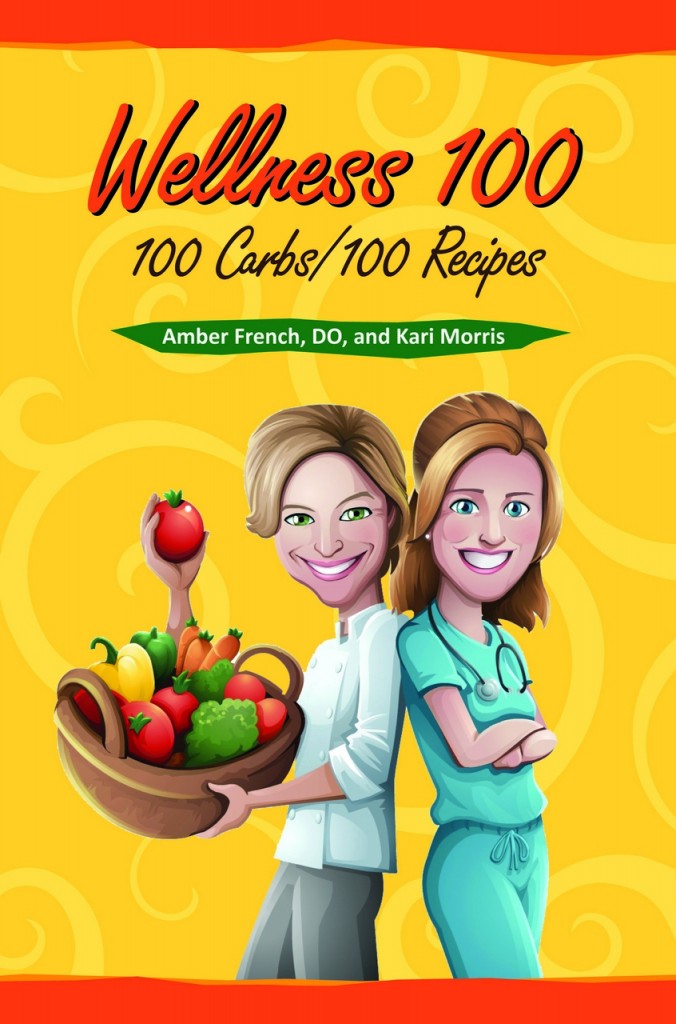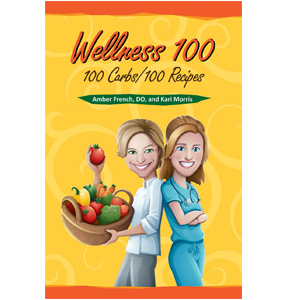Dr. Amber French, FACOOG, is a practicing OB/GYN in North Georgia and is board certified in anti-aging and regenerative medicine. Her practice is geared toward bio-identical hormone replacement therapy, nutrition, and natural therapies. After developing a nutrition and weight loss program for herself, she formalized the information and began helping her patients achieve lasting weight loss in a manner that was healthy and beneficial to their bodies.
 Kari Morris is a restaurateur and caterer, gardener, and marketer. She has a degree in journalism from The University of Texas at Austin with a specialization in public relations. She lives in Dahlonega, Georgia, where she owned and operated a restaurant and filled a niche for freshly prepared, casual, and affordable dishes. In 2011, Kari achieved weight loss goals and is happily eating and entertaining according to the guidelines of Wellness 100.
Kari Morris is a restaurateur and caterer, gardener, and marketer. She has a degree in journalism from The University of Texas at Austin with a specialization in public relations. She lives in Dahlonega, Georgia, where she owned and operated a restaurant and filled a niche for freshly prepared, casual, and affordable dishes. In 2011, Kari achieved weight loss goals and is happily eating and entertaining according to the guidelines of Wellness 100.
1. Why is the book titled “Wellness 100”? Could you tell us what is the reason why you and Kari Morris write this book?
Wellness 100 refers to the maximum daily intake of grams of carbohydrates that is the core of the program (100 total: 30 at each meal and 10 in snacks) and the 100 recipes that are examples of how to eat according to the guidelines. We co-authored this book to teach the science behind eating well and healthfully and to show that eating this way can also be flavorful and satisfying. You can have it both ways.
I see many patients who struggle with weight gain and the disappointment of “yo-yoing” (weight loss followed by weight gain) brought on by the constant pursuit of fad diets. Today, many people do not know how to eat for long term weight management and better health. My passion for anti-aging and regenerative medicine led me to address weight loss, weight maintenance, and the diseases of aging through a natural remedy: nutrition.
2. Your book is a nutritional program and cookbook designed to help readers lose weight and combat diseases, what are the principles or guidelines that your recipes are based upon to help readers get rid of diabetes, heart disease, cancer, stroke, and obesity?
People should avoid processed foods and consume real, fresh foods in the proper ratio of healthy carbohydrates to lean meat (protein) with a moderate intake of dairy. Wellness 100 also urges people to eat a “salad a day” for increased consumption of raw vegetables, to eat healthy fats, to never eat trans fats, and to exercise moderately on a regular basis.
3. What are your thoughts about the causes of obesity, diabetes, stroke, and cancer in America?
A modern American diet can contribute greatly to all of these diseases. The obesity epidemic in our country is largely caused by eating too many processed foods and their accompanying sauces, starches, preservatives, and excess carbohydrates. High blood sugar and diabetes often are brought on by eating too many carbohydrates or by eating (or drinking) carbohydrates without protein and thus elevating blood sugar levels. We need carbohydrates in our diet for proper brain function, but we need them in a non-processed form such as vegetables, fruits, and whole grains.
4. What do you think is the biggest mistake people make when trying to start a weight loss plan?
People look for a “magic pill” and expect to lose weight without changing their overall eating habits. They want to drop weight fast and then go back to their old habits. Wellness 100 is a lifestyle program rather than a “diet.” No shots, no pills, and no fad diets will lead to long term success. Wellness 100 is about adopting lifelong eating habits for better health – weight loss is just one of the great side effects.
5. What kind of success have you seen with your dietary recommendations and what scientific support do you have for them?
I have been using this program with my patients for over 3 years. Yes, they lose weight which makes them happy but their blood sugars and cholesterol levels improve greatly which as their doctor, makes me happy. In putting together the recommendations in the book I read over 250 research articles and numerous books.
6. What makes “Wellness 100” a great book for readers from a number of weight loss cookbooks available in the market?
Our collaboration results in one “go-to” book that spells out what you should eat and why, and then gives delicious examples for all three meals and snacks. I tried to clearly and concisely condense the science and research behind the guidelines. For example, I explain in layman terms why eating excessive carbohydrates leads to higher cholesterol and diabetes. Kari’s recipes and cooking tips help you put the program into action. She designed the recipes for busy home cooks and uses readily available ingredients.
Also, the program is not too restrictive. It’s not a very low-carbohydrate diet, or a very low-fat diet, or a very low-calorie diet. After you learn how to limit or avoid certain carbohydrates and include lean meat and good fats in your diet, there are no difficult calculations.
7. Could you share with us on average how much weight does your clients usually lose while following the rules and strategies in the “Wellness 100”? And what is the ONE thing that helps them to lose weight?
Patients lose 1-2 pounds per week following Wellness 100, but it can vary depending on many factors, such as how much they need to change their diet to meet the guidelines or how often they exercise. People’s eating habits are so variable, that it is impossible for any weight loss program to promise specific results across the board. Removing excess sugar in its myriad forms (including high fructose corn syrup, white flour, white rice, and white potatoes) results in quick weight loss over the short term, but healthy, lasting weight loss comes with adoption of all of the guidelines.
8. What other benefits should a person expect following the recipes in your book aside from losing weight, cancer and diabetes? Is the book suitable for everyone?
This book is written to be suitable for everyone, including families. I do not recommend counting calories for most children but the basics should be taught so that children can develop lifelong healthy habits. Aside from weight loss, anyone following the program can expect more energy and an improved overall sense of wellbeing. Many menopausal patients also experience fewer hot flashes with the program.
9. What are the difficulties faced when trying to lose weight and how does it become easy by following your book? Could you share some of the experiences that your clients have gone through following the recipes in your book?
Wellness 100 includes a variety of lists and resources to help you succeed. A pantry list and shopping list help you stock your pantry. A glycemic index chart shows which vegetables, grains, and fruits to choose. Every recipe includes a nutrition analysis so you can learn proper portions. A nutrition analysis for common ingredients helps you prepare your own dishes. The 100 recipes provide variety and seasonality to help you stay excited about eating healthfully as you learn the program.
10. Do you have anything specific or advice that you want to say to the readers who are struggling to lose weight to help them shed the fats?
This program may be different than the way you normally eat but it is not hard to follow. As with any change it will take several weeks for it to become habit but once it does you will enjoy eating like this. My patients often tell me that after following the program for a while when they try to have a “cheat night” and go back to bad habits they feel terrible and it serves as a good reminder why they have decided to follow Wellness 100.
You can visit their website at http://wellness100.us/

Leave a Reply